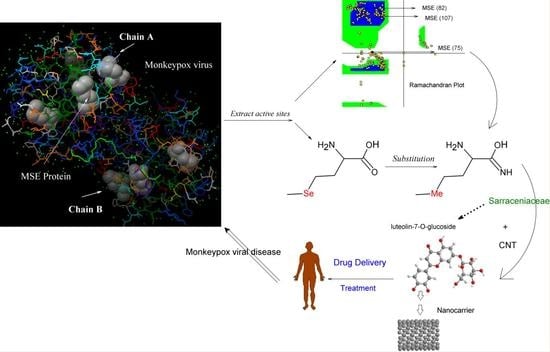Computational Methods in the Drug Delivery of Carbon Nanocarriers onto Several Compounds in Sarraceniaceae Medicinal Plant as Monkeypox Therapy
Abstract
1. Introduction
2. Theoretical Frameworks and Computational Methods
3. Results and Discussion
3.1. Nuclear Magnetic Resonance Data
3.2. Charge Transfer
3.3. Infrared Spectra Analysis
3.4. HOMO and LUMO Analysis
3.5. UV-VIS Spectroscopies
4. Conclusions
Funding
Data Availability Statement
Acknowledgments
Conflicts of Interest
References
- Petersen, B.W.; Damon, I.K. Smallpox, monkeypox and other poxvirus infections. In Goldman-Cecil Medicine, 26th ed.; Lee, G., Andrew, I.S., Eds.; Elsevier: Philadelphia, PA, USA, 2020; Volume 2, pp. 2180–2183. ISBN 978-0-323-53266-2. [Google Scholar]
- Sutcliffe, C.G.; Rimone, A.W.; Moss, W.J. Poxviruses. In Hunter’s Tropical Medicine and Emerging Infectious Diseases E-Book, 10th ed.; Ryan, E.T., Hill, D.R., Solomon, T., Aronson, N., Endy, T.P., Eds.; Elsevier: Edinburgh, UK, 2020; pp. 272–277. ISBN 978-0-323-55512-8. [Google Scholar]
- Harris, E. What to Know About Monkeypox. JAMA 2022, 327, 2278–2279. [Google Scholar] [CrossRef] [PubMed]
- Simpson, K.; Heymann, D.; Brown, C.S.; Edmunds, W.J.; Elsgaard, J.; Fine, P.; Hochrein, H.; Hoff, N.A.; Green, A.; Ihekweazu, C.; et al. Human monkeypox—After 40 years, an unintended consequence of smallpox eradication. Vaccine 2020, 38, 5077–5081. [Google Scholar] [CrossRef] [PubMed]
- Bunge, E.M.; Hoet, B.; Chen, L.; Lienert, F.; Weidenthaler, H.; Baer, L.R.; Steffen, R. The changing epidemiology of human monkeypox-A potential threat? A systematic review. PLoS Negl. Trop. Dis. 2022, 16, e0010141. [Google Scholar] [CrossRef]
- Minasov, G.; Inniss, N.L.; Shuvalova, L.; Anderson, W.F.; Satchell, K.J.F. Structure of the Monkeypox virus profilin-like protein A42R reveals potential functional differences from cellular profilins. Acta Crystallogr. F Struct. Biol. Commun. 2022, 78, 371–377. [Google Scholar] [CrossRef]
- Barlow, G.; Irving, W.L.; Moss, P.J. Infectious disease. In Kumar and Clark’s Clinical Medicine, 10th ed.; Feather, A., Randall, D., Waterhouse, M., Eds.; Elsevier: Amsterdam, The Netherlands, 2020; p. 517. ISBN 978-0-7020-7870-5. [Google Scholar]
- Hutin, Y.J.; Williams, R.J.; Malfait, P.; Pebody, R.; Loparev, V.N.; Ropp, S.L.; Rodriguez, M.; Knight, J.C.; Tshioko, F.K.; Khan, A.S.; et al. Outbreak of human monkeypox, Democratic Republic of Congo, 1996 to 1997. Emerg. Infect. Dis. 2001, 7, 434–438. [Google Scholar] [CrossRef]
- Arndt, W.; Mitnik, C.; Denzler, K.L.; White, S.; Waters, R.; Jacobs, B.L.; Rochon, Y.; Olson, V.A.; Damon, I.K.; Langland, J.O. In Vitro Characterization of a Nineteenth-Century Therapy for Smallpox. PLoS ONE 2012, 7, e32610. [Google Scholar] [CrossRef]
- Nadar, S.; Khan, T.; Omri, A. Reemergence of monkeypox: Prevention and management. Expert Rev. Anti-Infect. Ther. 2022, 20, 1425–1433. [Google Scholar] [CrossRef]
- Abubakar, I.B.; Kankara, S.S.; Malami, I.; Danjuma, J.B.; Muhammad, Y.Z.; Yahaya, H.; Singh, D.; Usman, U.J.; Ukwuani-Kwaja, A.N.; Muhammad, A.; et al. Traditional medicinal plants used for treating emerging and re-emerging viral diseases in northern Nigeria. Eur. J. Integr. Med. 2022, 49, 102094. [Google Scholar] [CrossRef]
- Millspaugh, C.F. American Medicinal Plants: An Illustrated and Descriptive Guide to Plants Indigenous to and Naturalized in the United States Which Are Used in Medicine (Illustrated ed.); Courier Corporation: Chelmsford, MA, USA, 1892; p. 76. ISBN 9780486230344. [Google Scholar]
- Mollaamin, F.; Monajjemi, M. Thermodynamic research on the inhibitors of coronavirus through drug delivery method. J. Chil. Chem. Soc. 2021, 66, 5195–5205. [Google Scholar] [CrossRef]
- Tiwari, G.; Tiwari, R.; Sriwastawa, B.; Bhati, L.; Pandey, S.; Pandey, P.; Bannerjee, S.K. Drug delivery systems: An updated review. Int. J. Pharm. Investig. 2012, 2, 2–11. [Google Scholar] [CrossRef]
- Monajjemi, M.; Shahriari, S. Fatemeh Mollaamin, Evaluation of Coronavirus Families & Covid-19 Proteins: Molecular Modeling Study. Biointerface Res. Appl. Chem. 2020, 10, 6039–6057. [Google Scholar] [CrossRef]
- Mollaamin, F. On the behavior of boron nitride Nanotube-Flavin adenine Dinucleotide interaction ion implantation order to design Biofuel cells. J. Comput. Theor. Nanosci. 2014, 11, 2017–2022. [Google Scholar] [CrossRef]
- Monajjemi, M.; Honaparvar, B.; Khalili Hadad, B.; Ilkhani, A.; Mollaamin, F. Thermo-Chemical Investigation and NBO Analysis of Some anxileotic as Nano- Drugs. Afr. J. Pharm. Pharmacol. 2010, 4, 521–529. [Google Scholar]
- Singh, A.P.; Biswas, A.; Shukla, A.; Maiti, P. Targeted therapy in chronic diseases using nanomaterial-based drug delivery vehicles. Signal Transduct. Target. Ther. 2019, 4, 33. [Google Scholar] [CrossRef]
- Mollaamin, F.; Monajjemi, M. Harmonic Linear Combination and Normal Mode Analysis of Semiconductor Nanotubes Vibrations. J. Comput. Theor. Nanosci 2015, 12, 1030–1039. [Google Scholar] [CrossRef]
- Khaleghian, M.; Zahmatkesh, M.; Mollaamin, F.; Monajjemi, M. Investigation of Solvent Effects on Armchair Single-Walled Carbon Nanotubes: A QM/MD Study. Fuller. Nanotub. Carbon Nanostructures 2011, 19, 251–261. [Google Scholar] [CrossRef]
- Ghalandari, B.; Monajjemi, M.; Mollaamin, F. Theoretical Investigation of Carbon Nanotube Binding to DNA in View of Drug Delivery. J. Comput. Theor. Nanosci. 2011, 8, 1212–1219. [Google Scholar] [CrossRef]
- Khalili Hadad, B.; Mollaamin, F.; Monajjemi, M. Biophysical chemistry of macrocycles for drug delivery: A theoretical study. Russ. Chem. Bull. 2011, 60, 238–241. [Google Scholar] [CrossRef]
- Sarasia, E.M.; Afsharnezhad, S.; Honarparvar, B.; Mollaamin, F.; Monajjemi, M. Theoretical study of solvent effect on NMR shielding tensors of luciferin derivatives. Phys. Chem. Liquids 2011, 49, 561–571. [Google Scholar] [CrossRef]
- Mollaamin, F. Physicochemical Investigation of Anti-COVID19 Drugs Using Several Medicinal Plants. J. Chil. Chem. Soc. 2022, 67, 5537–5546. [Google Scholar] [CrossRef]
- Mahdavian, L.; Monajjemi, M. Alcohol sensors based on SWNT as chemical sensors: Monte Carlo and Langevin dynamics simulation. Microelectron. J. 2010, 41, 142–149. [Google Scholar] [CrossRef]
- Monajjemi, M.; Baheri, H.; Mollaamin, F. A percolation model for carbon nanotube-polymer composites using the Mandelbrot-Given. J. Struct. Chem. 2011, 52, 54–59. [Google Scholar] [CrossRef]
- Tahan, A.; Mollaamin, F.; Monajjemi, M. Thermochemistry and NBO analysis of peptide bond: Investigation of basis sets and binding energy. Russ. J. Phys. Chem. A 2009, 83, 587–597. [Google Scholar] [CrossRef]
- Frisch, M.J.; Trucks, G.W.; Schlegel, H.B.; Scuseria, G.E.; Robb, M.A.; Cheeseman, J.R.; Scalmani, G.; Barone, V.; Petersson, G.A.; Nakatsuji, H.; et al. Gaussian 16, Revision C.01; Gaussian, Inc.: Wallingford, CT, USA, 2016. [Google Scholar]
- Lee, C.; Yang, W.; Parr, R.G. Development of the Colle-Salvetti Correlation-Energy Formula into a Functional of the Electron Density. Phys. Rev. B 1988, 37, 785–789. [Google Scholar] [CrossRef]
- Koch, W.; Holthausen, M.C. A Chemist’s Guide to Density Functional Theory, 2nd ed.; Wiley-VCH: Weinheim, Germany, 2000; Volume 3–64, pp. 93–104. [Google Scholar]
- Becke, A.D. Density-Functional Exchange-Energy Approximation with Correct Asymptotic Behavior. Phys. Rev. A 1988, 38, 3098–3100. [Google Scholar] [CrossRef]
- Bakhshi, K.; Mollaamin, F.; Monajjemi, M. Exchange and correlation effect of hydrogen chemisorption on nano V(100) surface: A DFT study by generalized gradient approximation (GGA). J. Comput. Theor. Nanosci. 2011, 8, 763–768. [Google Scholar] [CrossRef]
- Monajjemi, M.; Khaleghian, M.; Tadayonpour, N.; Mollaamin, F. The effect of different solvents and temperatures on stability of single-walled carbon nanotube: A QM/MD study. Int. J. Nanosci. 2010, 9, 517–529. [Google Scholar] [CrossRef]
- Cramer, C.J.; Truhlar, D.G. PM3-SM3: A general parameterization for including aqueous solvation effects in the PM3 molecular orbital model. J. Comp. Chem. 1992, 13, 1089–1097. [Google Scholar] [CrossRef]
- Liotard, D.A.; Hawkins, G.D.; Lynch, G.C.; Cramer, C.J.; Truhlar, D.G. Improved methods for semiempirical solvation models. J. Comp. Chem. 1995, 16, 422–440. [Google Scholar] [CrossRef]
- Chambers, C.C.; Hawkins, G.D.; Cramer, C.J.; Truhlar, D.G. Model for aqueous solvation based on class IV atomic charges and first solvation shell effects. J. Phys. Chem. 1996, 100, 16385–16398. [Google Scholar] [CrossRef]
- Giesen, D.J.; Gu, M.Z.; Cramer, C.J.; Truhlar, D.G. A Universal Organic Solvation Model. J. Org. Chem. 1996, 61, 8720–8721. [Google Scholar] [CrossRef] [PubMed]
- Onsager, L.J. Electric Moments of Molecules in Liquids. J. Am. Chem. Soc. 1936, 58, 1486–1493. [Google Scholar] [CrossRef]
- Tomasi, J. Cavity and reaction field: “Robust” concepts. Perspective on “Electric moments of molecules in liquids”. Theor. Chem. Acc. 2000, 103, 196–199. [Google Scholar] [CrossRef]
- Zadeh, M.A.A.; Lari, H.; Kharghanian, L.; Balali, E.; Khadivi, R.; Yahyaei, H.; Mollaamin, F.; Monajjemi, M. Density functional theory study and anti-cancer properties of shyshaq plant: In view point of nano biotechnology. J. Comput. Theor. Nanosci. 2015, 12, 4358–4367. [Google Scholar] [CrossRef]
- Mollaamin, F.; Monajjemi, M.; Salemi, S.; Baei, M.T. A Dielectric Effect on Normal Mode Analysis and Symmetry of BNNT Nanotube. Fuller. Nanotub. Carbon Nanostructures 2011, 19, 182–196. [Google Scholar] [CrossRef]
- Mollaamin, F.; Ilkhani, A.; Sakhaei, N.; Bonsakhteh, B.; Faridchehr, A.; Tohidi, S.; Monajjemi, M.; Fatemeh, M.; Alireza, I.; Neda, S.; et al. Thermodynamic and solvent effect on dynamic structures of nano bilayer-cell membrane: Hydrogen bonding study. J. Comput. Theor. Nanosci. 2015, 12, 3148–3154. [Google Scholar] [CrossRef]
- Mollaamin, F. Chemotherapy Study of alkaloids through Theoretical Quantum Methods. Moroc. J. Chemistry. 2020, 8, 400–411. [Google Scholar] [CrossRef]
- Fry, R.A.; Kwon, K.D.; Komarneni, S.; Kubicki, J.D.; Mueller, K.T. Solid-State NMR and Computational Chemistry Study of Mononucleotides Adsorbed to Alumina. Langmuir 2006, 22, 9281–9286. [Google Scholar] [CrossRef]
- Monajjemi, M.; Noei, M.; Mollaamin, F. Design of fMet-tRNA and Calculation of its Bonding Properties by Quantum Mechanics. Nucleosides Nucleotides Nucleic Acids 2010, 29, 676–683. [Google Scholar] [CrossRef]
- Monajjemi, M.; Robert, W.J.; Boggs, J.E. NMR contour maps as a new parameter of carboxyl’s OH groups in amino acids recognition: A reason of tRNA-amino acid conjugation. Chem. Phys. 2014, 433, 1–11. [Google Scholar] [CrossRef]
- Aihara, J. Reduced HOMO−LUMO Gap as an Index of Kinetic Stability for Polycyclic Aromatic Hydrocarbons. J. Phys. Chem. A 1999, 103, 7487–7495. [Google Scholar] [CrossRef]
- Kohn, W.; Becke, A.D.; Parr, R.G. Density Functional Theory of Electronic Structure. J. Phys. Chem. 1996, 100, 12974–12980. [Google Scholar] [CrossRef]
- Parr, R.G.; Pearson, R.G. Absolute Hardness: Companion Parameter to Absolute Electronegativity. J. Am. Chem. Soc. 1983, 105, 7512–7516. [Google Scholar] [CrossRef]
- Politzer, P.; Abu-Awwad, F. A comparative analysis of Hartree-Fock and Kohn-Sham orbital energies. Theor. Chem. Acc. 1998, 99, 83–87. [Google Scholar] [CrossRef]
- Silverstein, R.M.; Bassler, G.C.; Morrill, T.C. Spectrometric Identification of Organic Compounds, 5th ed.; John Wiley & Sons, Inc.: New York, NY, USA, 1981. [Google Scholar]
- Mollaamin, F. Features of Parametric Point Nuclear Magnetic Resonance of Metals Implantation on Boron Nitride Nanotube by Density Functional Theory/Electron Paramagnetic Resonance. J. Comput. Theor. Nanosci. 2014, 11, 2393–2398. [Google Scholar] [CrossRef]
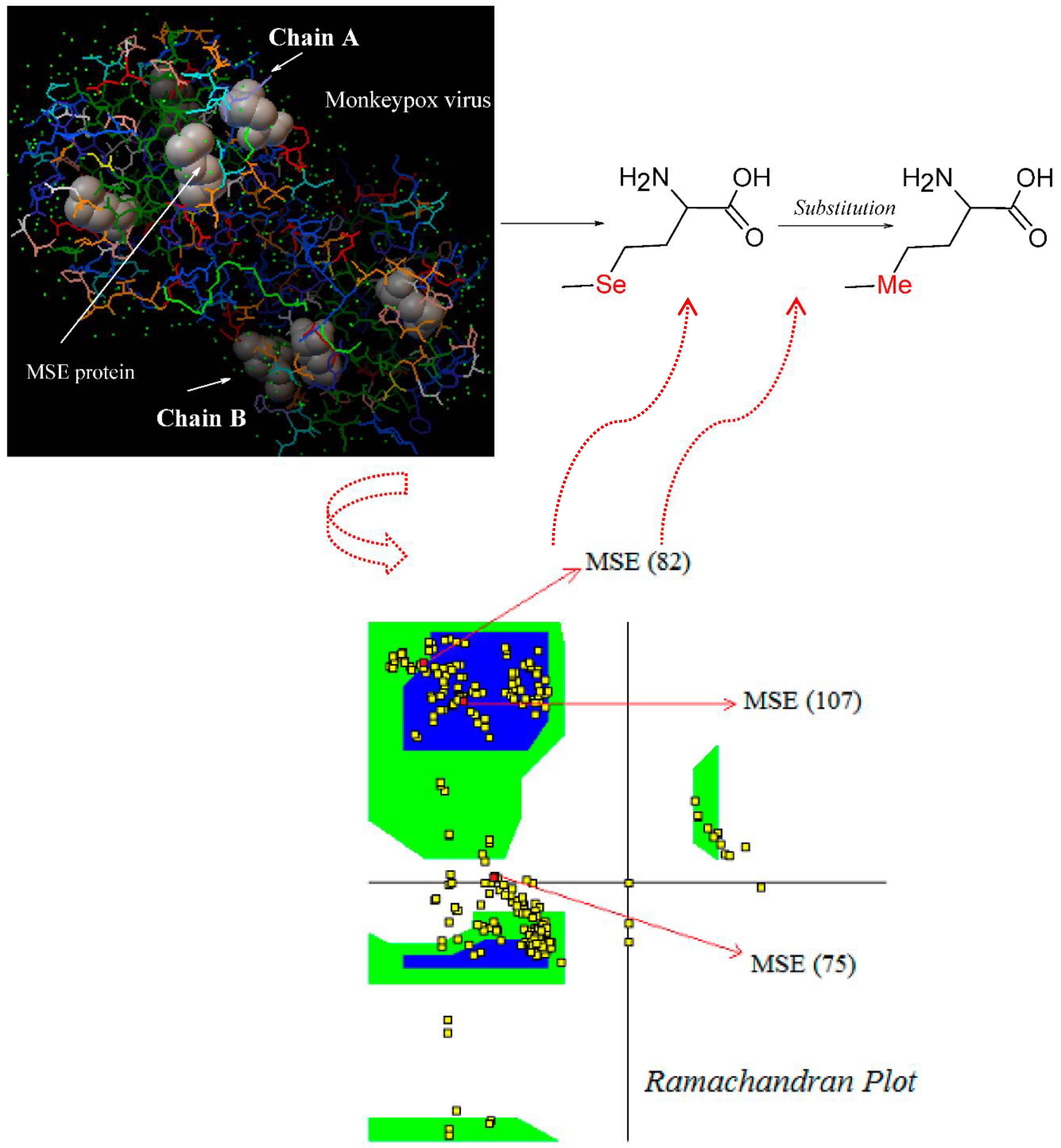
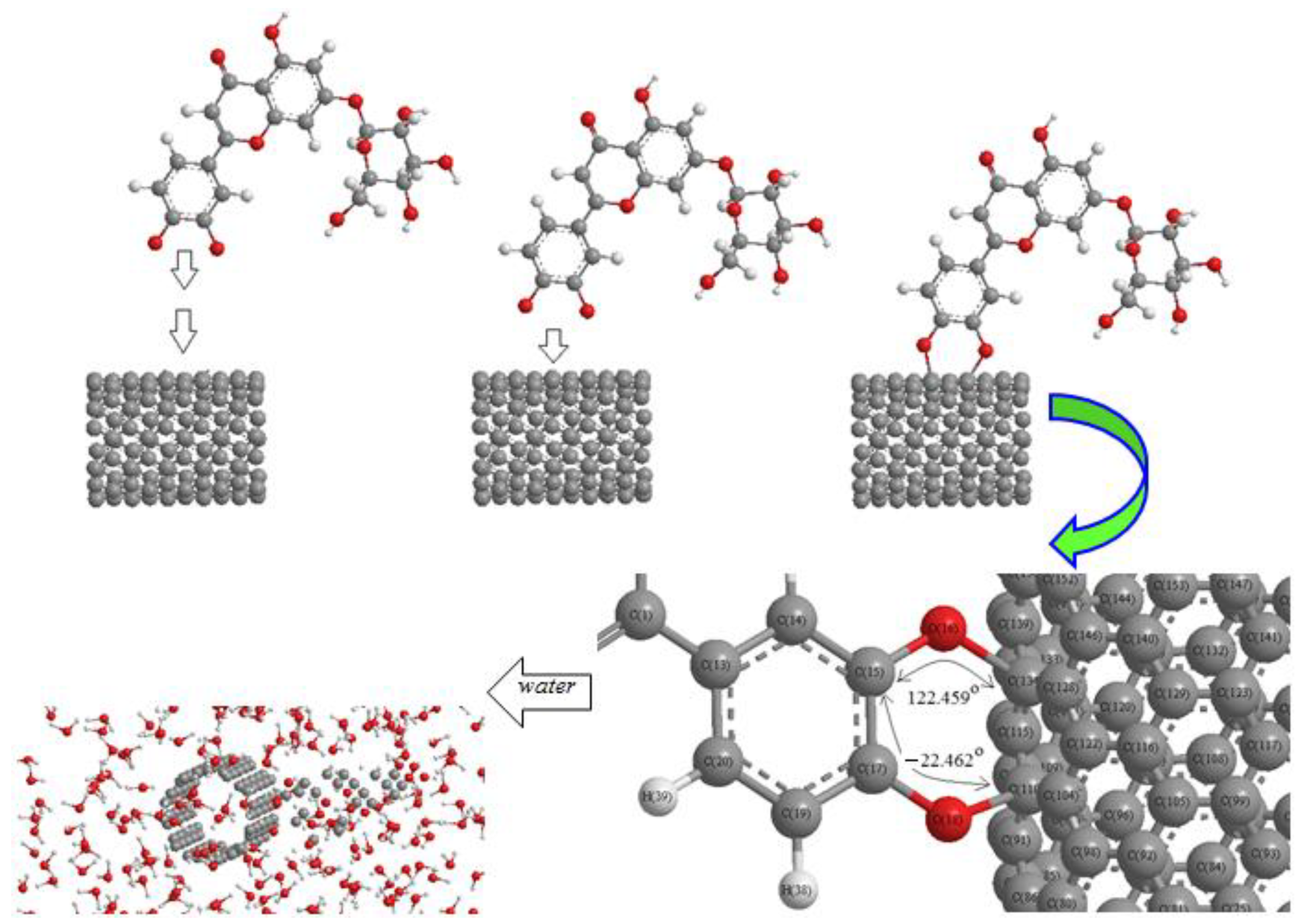


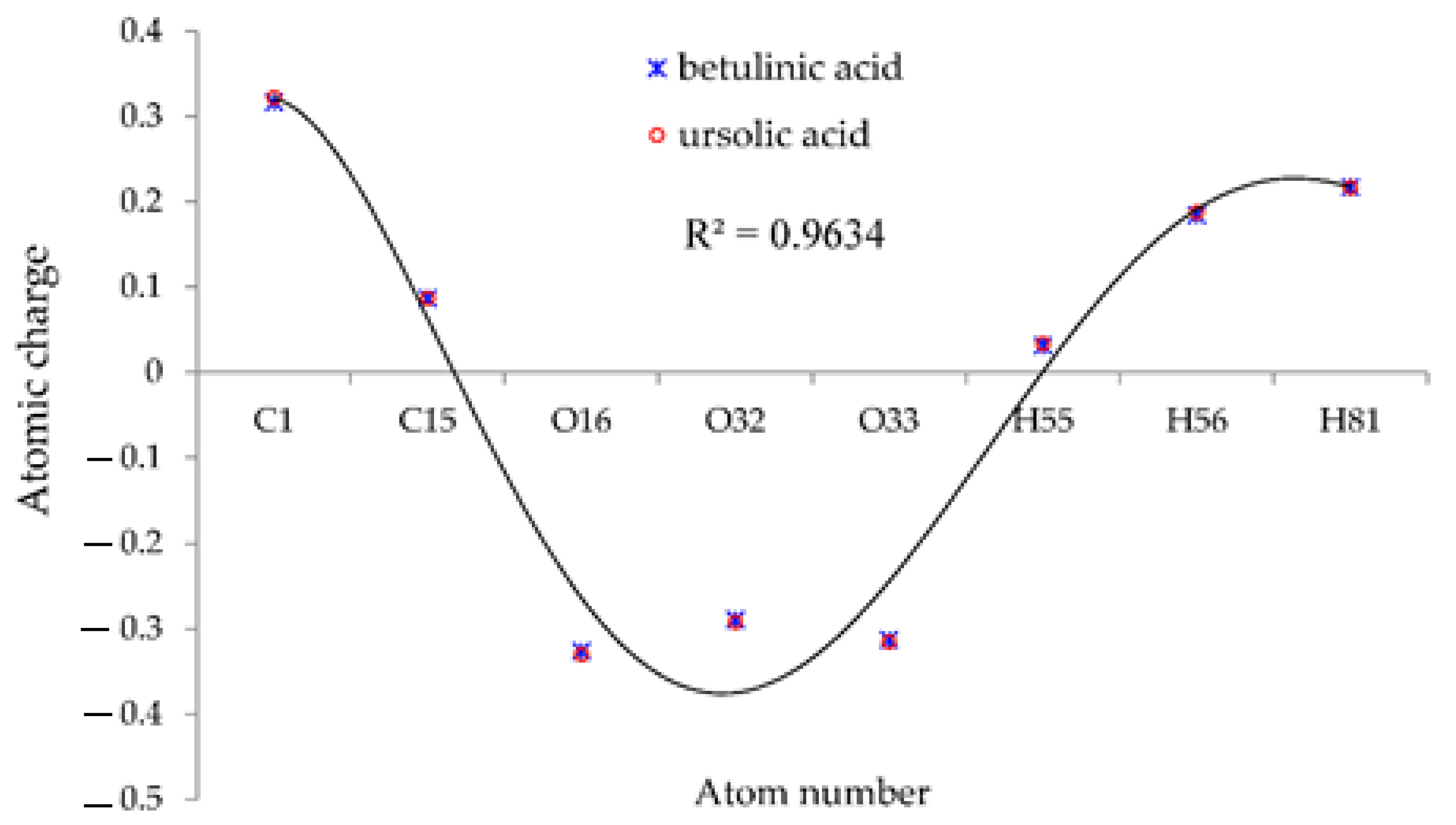
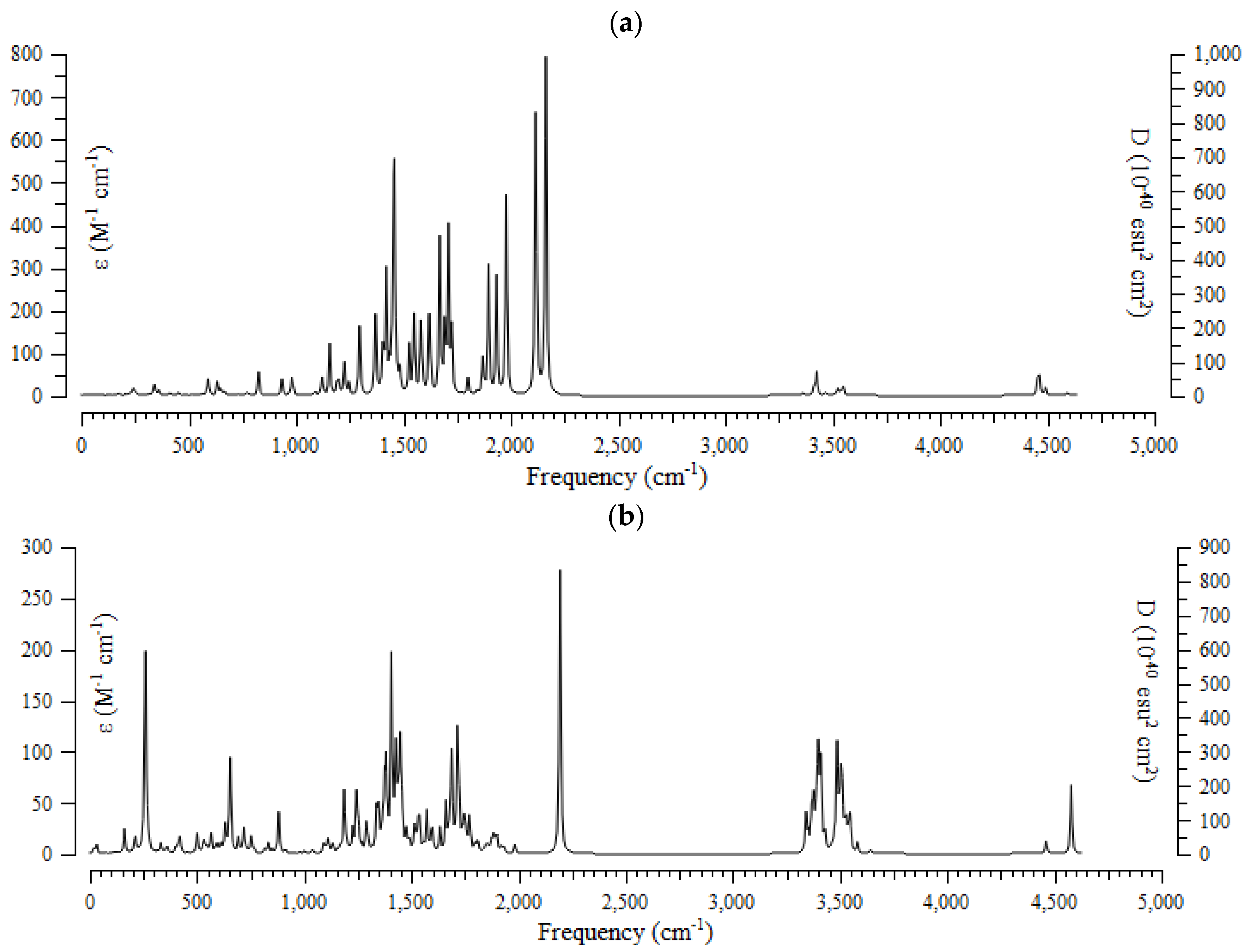
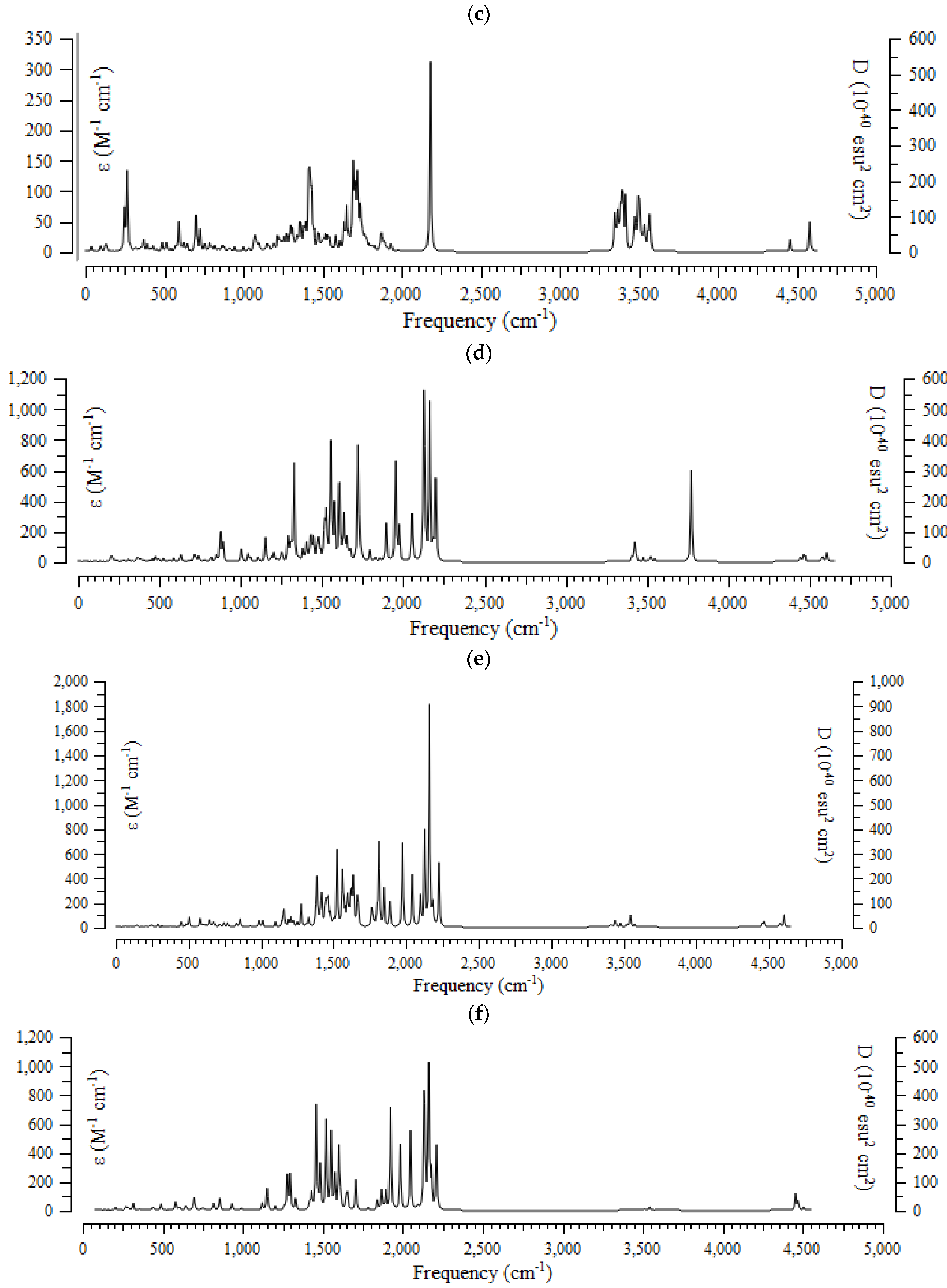

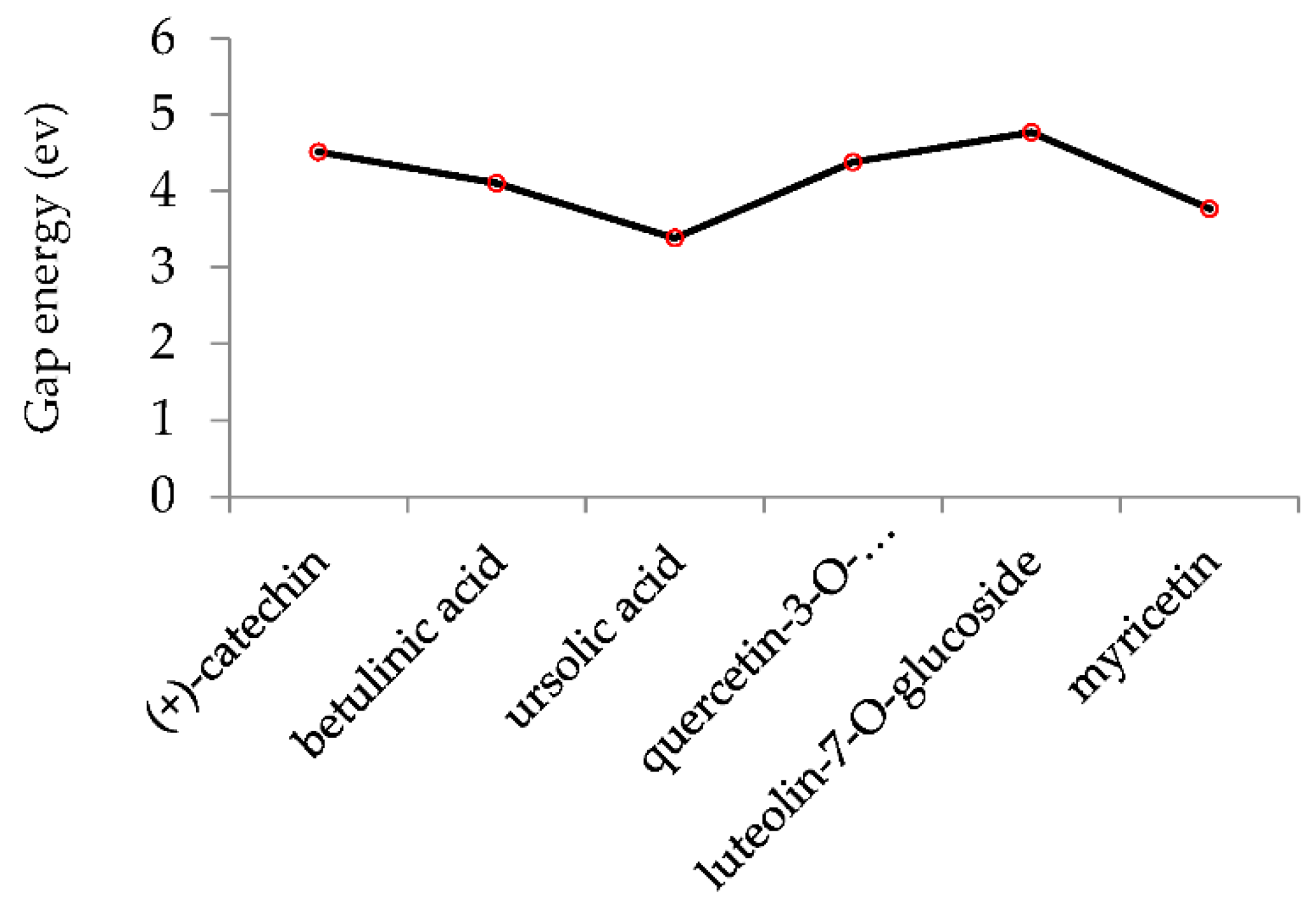
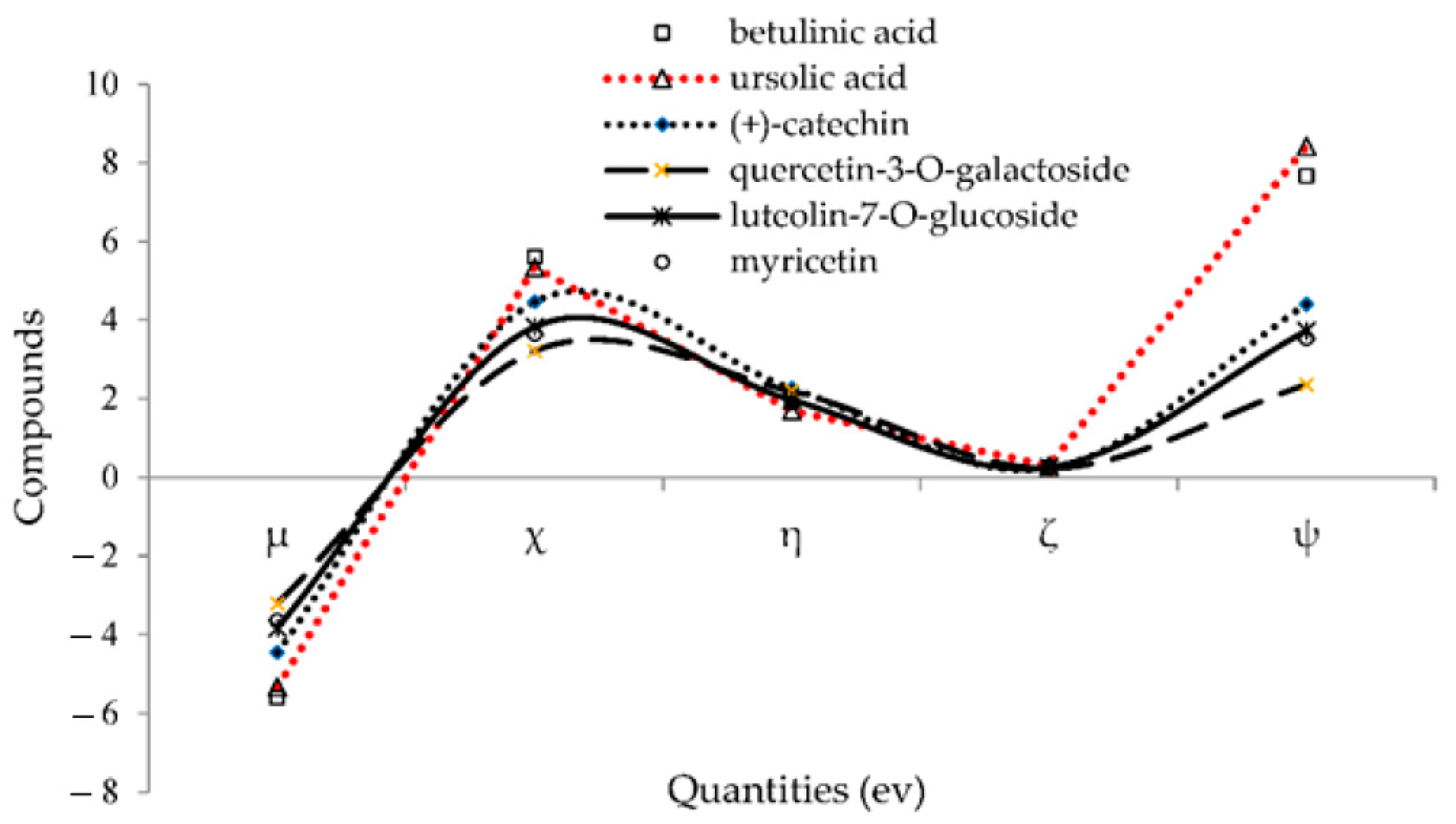



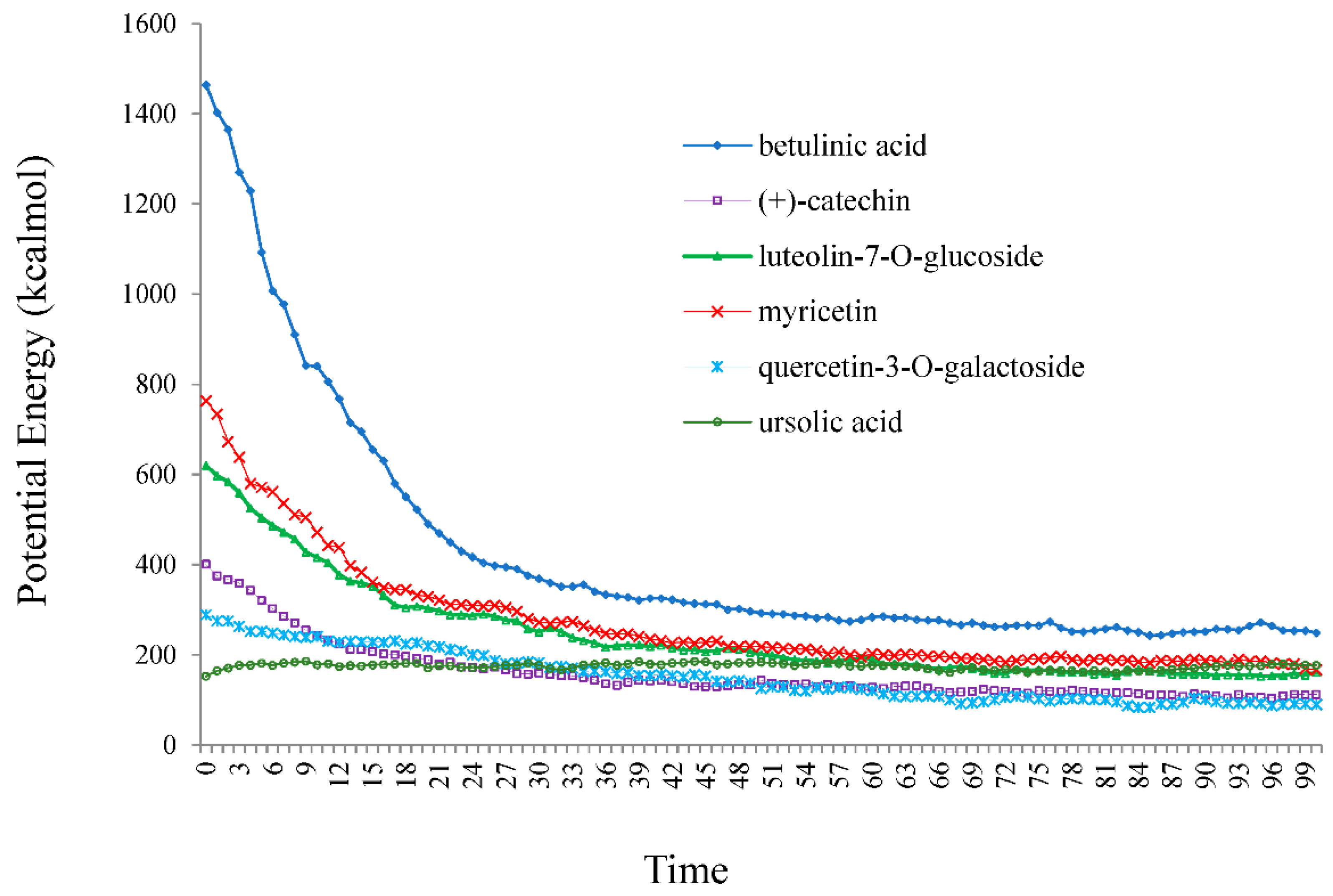
| (+)-catechin | ||||||||||
| ppm | C9 | O10 | C16 | O17 | C18 | O19 | H29 | H32 | H33 | |
| σ11 | 59.2865 | 290.7057 | 83.3679 | 294.7889 | 74.8748 | 314.0021 | 22.0139 | 18.3994 | 22.5452 | |
| σ22 | 95.0440 | 290.7057 | 96.1147 | 319.9473 | 102.1597 | 334.3497 | 29.1676 | 30.9900 | 29.3964 | |
| σ33 | 202.1101 | 324.1978 | 204.8543 | 371.6628 | 204.9966 | 339.3341 | 40.1023 | 39.0397 | 40.7560 | |
| σiso | 118.8135 | 312.0269 | 128.1123 | 328.7997 | 127.3437 | 329.2287 | 30.4279 | 29.4764 | 30.8992 | |
| σaniso | 124.9449 | 18.2563 | 115.1130 | 64.2947 | 116.4793 | 15.1582 | 14.5116 | 14.3450 | 14.7852 | |
| Q | 0.1421 | −0.2901 | 0.116237 | −0.2961 | 0.098471 | −0.3090 | 0.2138 | 0.2258 | 0.2213 | |
| betulinic acid | ||||||||||
| ppm | C1 | C15 | O16 | O32 | O33 | H55 | H56 | H81 | ||
| σ11 | −15.6362 | 169.1082 | 328.6384 | −503.6711 | 138.8698 | 28.0314 | 24.8297 | 21.7177 | ||
| σ22 | 154.9603 | 178.9003 | 337.9158 | −252.2589 | 310.1232 | 29.9588 | 31.6255 | 24.5804 | ||
| σ33 | 164.7082 | 209.4747 | 421.9830 | 450.9700 | 335.3043 | 37.4969 | 49.6449 | 38.4823 | ||
| σiso | 101.3441 | 185.8277 | 362.8457 | −101.6533 | 261.4324 | 31.8290 | 35.3667 | 28.2601 | ||
| σaniso | 95.0462 | 35.4704 | 88.7059 | 828.9350 | 110.8078 | 8.5018 | 21.4173 | 15.3332 | ||
| Q | 0.3171 | 0.0872 | −0.3262 | −0.2893 | −0.3130 | 0.0317 | 0.1843 | 0.2175 | ||
| ursolic acid | ||||||||||
| ppm | C1 | C2 | O3 | O32 | O33 | H34 | H35 | H81 | ||
| σ11 | −14.8985 | 170.5948 | 339.4528 | −466.2527 | 149.8814 | 27.2523 | 24.1463 | 22.1181 | ||
| σ22 | 159.4348 | 178.9689 | 347.9330 | −229.8480 | 312.0712 | 28.4278 | 31.8205 | 24.5591 | ||
| σ33 | 163.0061 | 206.2026 | 420.4447 | 448.6102 | 332.2916 | 39.6026 | 48.3531 | 38.8056 | ||
| σiso | 102.5141 | 185.2554 | 369.2768 | −82.4968 | 264.7481 | 31.7609 | 34.7733 | 28.4942 | ||
| σaniso | 90.7380 | 31.4207 | 76.7519 | 796.6605 | 101.3153 | 11.7626 | 20.3697 | 15.4670 | ||
| Q | 0.3222 | 0.0873 | −0.3302 | −0.2924 | −0.3153 | 0.0342 | 0.1880 | 0.2168 | ||
| quercetin-3-O-galactoside | ||||||||||
| ppm | C9 | O10 | C16 | O17 | C18 | O19 | H36 | H39 | H40 | |
| σ11 | 54.5792 | 281.0196 | 76.6664 | 302.9608 | 83.8594 | 322.1996 | 21.5989 | 18.9010 | 22.7514 | |
| σ22 | 92.8624 | 322.3705 | 97.9617 | 319.2503 | 118.3675 | 329.4509 | 29.5876 | 30.5873 | 29.1195 | |
| σ33 | 201.6165 | 322.7628 | 207.5362 | 372.0312 | 203.9020 | 342.7070 | 38.8885 | 38.9020 | 40.9307 | |
| σiso | 116.3527 | 308.7176 | 127.3881 | 331.4141 | 135.3763 | 331.4525 | 30.0250 | 29.4634 | 30.9339 | |
| σaniso | 127.8957 | 21.0677 | 120.2221 | 60.9256 | 135.3763 | 16.8818 | 13.2953 | 14.1579 | 14.9952 | |
| Q | 0.1521 | −0.2868 | 0.1158 | −0.2958 | 0.0999 | −0.3038 | 0.2187 | 0.2247 | 0.2208 | |
| luteolin-7-O-glucoside | ||||||||||
| ppm | C15 | O16 | C17 | O18 | C23 | O24 | C25 | O26 | H38 | H39 |
| σ11 | 80.5725 | 298.6345 | 71.3881 | 308.1253 | 178.5325 | 345.1945 | 175.2961 | 349.2208 | 18.1208 | 22.3625 |
| σ22 | 99.5240 | 320.6211 | 99.9390 | 331.7684 | 185.8453 | 355.1242 | 183.8870 | 360.3805 | 31.1043 | 29.0165 |
| σ33 | 203.2873 | 369.2133 | 204.0323 | 340.0012 | 214.9455 | 417.7007 | 210.8215 | 419.9940 | 39.1626 | 40.6486 |
| σiso | 127.7946 | 329.4896 | 125.1198 | 326.6316 | 193.1078 | 372.6731 | 190.0015 | 376.5317 | 29.4626 | 30.6759 |
| σaniso | 113.2391 | 59.5854 | 118.3688 | 20.0544 | 32.7566 | 67.5413 | 31.2300 | 65.1933 | 14.5501 | 14.9591 |
| Q | 0.1113 | −0.2977 | 0.1043 | −0.3065 | 0.0689 | −0.3163 | 0.0671 | −0.3289 | 0.2241 | 0.2229 |
| myricetin | ||||||||||
| ppm | C10 | O11 | C12 | C19 | O20 | O22 | H27 | H28 | H31 | H32 |
| σ11 | 53.5046 | 279.3475 | 99.6682 | 97.7369 | 313.5489 | 316.0992 | 21.6415 | 19.8020 | 18.5542 | 22.3030 |
| σ22 | 92.4576 | 322.1245 | 142.5628 | 101.4764 | 329.1589 | 334.0617 | 29.3435 | 30.2446 | 31.2943 | 29.8787 |
| σ33 | 201.7495 | 322.9617 | 223.6607 | 205.2742 | 387.8727 | 337.0559 | 38.9144 | 31.4497 | 39.4524 | 40.5172 |
| σiso | 115.9039 | 308.1446 | 155.2972 | 134.8292 | 343.5269 | 329.0723 | 29.9665 | 27.1654 | 29.7670 | 30.8996 |
| σaniso | 128.7684 | 22.2257 | 102.5452 | 105.6675 | 66.5188 | 11.9754 | 13.4219 | 6.4264 | 14.5282 | 14.4263 |
| Q | 0.1544 | −0.2859 | −0.1240 | 0.0836 | −0.3111 | -0.3086 | 0.2200 | 0.0580 | 0.2343 | 0.2219 |
| Compounds | ∆G × 10−3 | ∆H × 10−3 | ∆S | Dipole Moment (Debye) |
|---|---|---|---|---|
| (+)-catechin | −634.993 | −634.958 | 117.270 | 2.3245 |
| betulinic acid | −860.291 | −860.242 | 161.600 | 1.5023 |
| ursolic acid | −860.275 | −860.229 | 151.479 | 1.4017 |
| quercetin-3-O-galactoside | −1055.740 | −1055.697 | 142.287 | 5.4546 |
| luteolin-7-O-glucoside | −1009.555 | −1009.514 | 138.448 | 5.4520 |
| myricetin | −726.155 | −957.555 | 112.043 | 2.2361 |
| Compounds | ELUMO (ev) | EHOMO (ev) | ∆E = ELUMO – EHOMO (ev) |
|---|---|---|---|
| (+)-catechin |  −2.1960 | 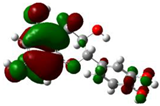 −6.7125 | 4.5165 |
| betulinic acid | 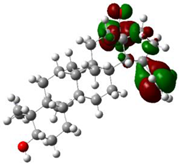 −3.5556 | 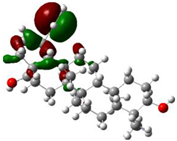 −7.6586 | 4.103 |
| ursolic acid |  −3.6444 |  −7.0303 | 3.3859 |
| quercetin-3-O-galactoside |  −1.0222 | 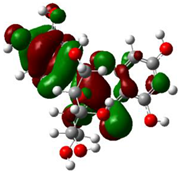 −5.4036 | 4.3814 |
| luteolin-7-O-glucoside | 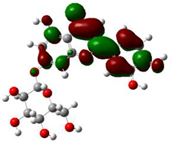 −1.8610 | 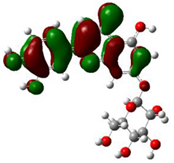 −5.7944 | 4.7722 |
| myricetin |  −1.7644 |  −5.5318 | 3.7674 |
| Compound Quantities (ev) | (+)-catechin | Betulinic Acid | Ursolic Acid | quercetin-3-O-galactoside | luteolin-7-O-glucoside | Myricetin |
|---|---|---|---|---|---|---|
| µ | −4.45425 | −5.6071 | −5.33735 | −3.2129 | −3.8277 | −3.6481 |
| χ | 4.45425 | 5.6071 | 5.33735 | 3.2129 | 3.8277 | 3.6481 |
| η | 2.25825 | 2.0515 | 1.69295 | 2.1907 | 1.9667 | 1.8837 |
| ζ | 0.2214 | 0.2437 | 0.2953 | 0.2282 | 0.2542 | 0.2654 |
| ψ | 4.3928 | 7.6625 | 8.4135 | 2.3560 | 3.7248 | 3.5326 |
Disclaimer/Publisher’s Note: The statements, opinions and data contained in all publications are solely those of the individual author(s) and contributor(s) and not of MDPI and/or the editor(s). MDPI and/or the editor(s) disclaim responsibility for any injury to people or property resulting from any ideas, methods, instructions or products referred to in the content. |
© 2023 by the author. Licensee MDPI, Basel, Switzerland. This article is an open access article distributed under the terms and conditions of the Creative Commons Attribution (CC BY) license (https://creativecommons.org/licenses/by/4.0/).
Share and Cite
Mollaamin, F. Computational Methods in the Drug Delivery of Carbon Nanocarriers onto Several Compounds in Sarraceniaceae Medicinal Plant as Monkeypox Therapy. Computation 2023, 11, 84. https://doi.org/10.3390/computation11040084
Mollaamin F. Computational Methods in the Drug Delivery of Carbon Nanocarriers onto Several Compounds in Sarraceniaceae Medicinal Plant as Monkeypox Therapy. Computation. 2023; 11(4):84. https://doi.org/10.3390/computation11040084
Chicago/Turabian StyleMollaamin, Fatemeh. 2023. "Computational Methods in the Drug Delivery of Carbon Nanocarriers onto Several Compounds in Sarraceniaceae Medicinal Plant as Monkeypox Therapy" Computation 11, no. 4: 84. https://doi.org/10.3390/computation11040084
APA StyleMollaamin, F. (2023). Computational Methods in the Drug Delivery of Carbon Nanocarriers onto Several Compounds in Sarraceniaceae Medicinal Plant as Monkeypox Therapy. Computation, 11(4), 84. https://doi.org/10.3390/computation11040084






